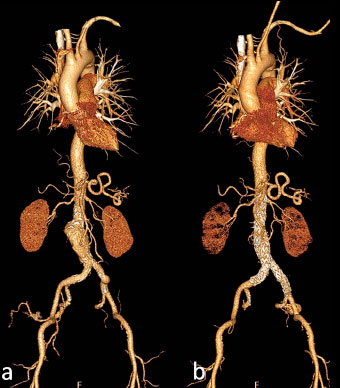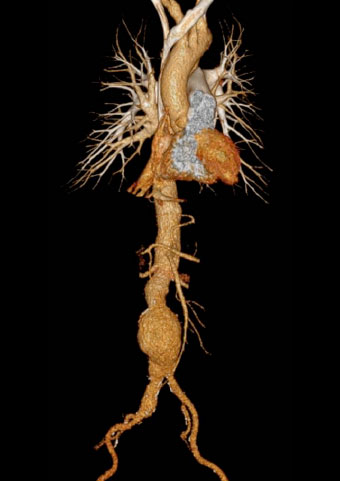Areas of Clinical Expertise
Main artery (aorta)
- What is an aoric aneurysm?
- What is the result?
- How can you discover an aortic aneurysm and what symptoms does it cause?
- When is an abdominal aortic aneurysm treated?
- What treatment options are there?
- You can make an appointment here
What is an aortic aneurysm?
An aneurysm is the extension of a blood vessel by more than 50% of its diameter (> 1.5 times). The main artery in this case represents the largest blood vessel in the human body, along which the oxygen-rich blood to supply the different organs and body regions flows. About 80% of aortal aneurysms are located in the abdomen, below the renal artery outflows.
What is the result?
Due to the pulsatile pressure of the blood flow in the aorta, an extension may burst (rupture). The risk of bursting thereby increases with diameter size. However, other risk factors affect the likelihood of aneurysm rupture. These include in particular the shape of the aneurysm (saccular), hypertension, obstructive pulmonary disease, smoking or a family history. The rupture of an aneurysm can quickly lead to internal bleeding to death. Even if an emergency operation is possible – almost 80% of patients no longer reach the hospital and in 90% of cases a rupture ends fatally.
How can you discover an aortic aneurysm and what symptoms does it cause?
An aortic aneurysm does not usually cause any symptoms, so that often the diagnosis is only made by chance. The diagnosis of an aortic aneurysm can be confirmed by means of different imaging methods. The simplest method of investigation in this case is an ultrasonic examination. The aneurysm can also be controlled in the course of the procedure, if an operation is still not necessary. For a more detailed assessment and planning the appropriate surgical treatment, computed tomography angiography should be performed. Magnetic resonance imaging can show an aortic aneurysm, but due to the long duration of the examination and the lack of feasibility for those with metallic implants in the body, it is only of secondary importance for diagnosis.
The symptoms of abdominal aortic aneurysm are difficult to detect and are usually expressed as abdominal or back pain. This can often lead to confusion with other diseases.
In very thin patients or very large aneurysms, these can be felt as a pulsating tumour in the abdomen.
If the aneurysm bursts, there is usually destructive pain made in the abdomen or back. Due to the resulting blood loss, it can quickly lead to poor circulation or even unconsciousness.
It is also important that other parts of the body are examined for vascular aneurysms, as they may be affected in patients with an abdominal aortic aneurysm. The main points include the popliteal, inguinal and neck regions.
When is an abdominal aortic aneurysm treated?
The need for surgery depends in particular on the diameter, but also on the shape of the aneurysm. An operation is usually necessary from a diameter of approximately 5 cm. With rapid growth in size, symptomatic aneurysm and aneurysm with a special form may also have to be operated on at a smaller diameter.
The risk of surgery for aortic aneurysms depends on several factors (including locality and health of the patient). but in such cases interventions at specialised clinics have by far the lowest surgical risk, due to accumulated experience.
You should have the various treatment options explained to you in more detail, along with their advantages and disadvantages, in our aorta clinic. Here you can consult our senior physician PD Dr A. Zimmermann, with his years of experience in all areas of aneurysm treatment.
What treatment options are there?
- Conservative therapy is recommended
When aneurysms do not meet the requirement for surgical treatment, drug treatment, i.e. conservative treatment, should be performed. This must be individually adapted to the patient’s situation and possibly includes medication for blood pressure and cholesterol reduction, but also to inhibit the function of platelets.
The patient may also contribute to risk reduction by choosing a healthier and more conscious lifestyle.
- Open surgery
During open surgery, the extended portion of the aorta is replaced by a so-called vascular prosthesis via an abdominal incision or through an incision in the chest cavity. Here this prosthesis is sutured to the healthy portions of the aorta as a “replacement tube”. The advantage of this surgical procedure is that there are only a few follow-up procedures and an intervention rarely follows. Disadvantages include the larger cardiac stress during the operation, the greater access entry of opening the abdomen and the longer recovery period after surgery.
- Endovascular (minimally invasive) surgery
In minimally invasive surgery (endovascular aneurysm repair) a collapsed stent graft is introduced into the aorta through the femoral arteries and deployed there under X-ray control. Now the blood flows through the in-aortic prosthesis and no longer through the aneurysm. The advantage of this method is the low cardiac stress, so that this method can also be applied to patients with heart disease. Moreover, the surgery requires only two small incisions in the groin and after surgery recovery is generally very rapid.
For the treatment of longer aneurysm sections, special prostheses may be necessary, which may have small openings or arms to involve affected organ arteries.
This method occasionally requires secondary procedures that can usually, however, be performed through low-risk catheter procedures. In addition, long-term regular follow-up by ultrasound and computed tomography (CT) must be made.
Patient flyer (PDF)
BR-post (YouTube)

You can make an appointment here
 Centre for Vascular Medicine and Polyclinic of the Clinic for Vascular and Endovascular Surgery
Centre for Vascular Medicine and Polyclinic of the Clinic for Vascular and Endovascular Surgery
Ismaninger Str. 22
D-81675 München
Tel.: 089 4140-6666
If you have already had tests, please bring these to your appointment, gladly in CD format if available.


 Notfallkontakt
Notfallkontakt



